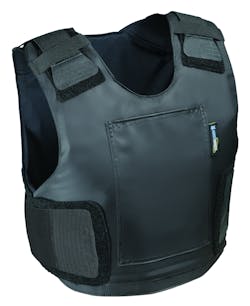Over the last 20 years, new materials and fabrics contributed significantly to the wearability of body armor. Today’s body armor systems boast increased ballistic protection, more flexibility, less weight and better comfort. Some in-vest materials even go so far as to protect against sharp-edged weapons and electromagnetic shock.
This is truly life-saving equipment. And as such, it needs to be treated with respect. Too often, improper ‘maintenance’ techniques damage the ballistic performance capabilities of armor. (And who can afford to run out and buy a second set?). If body armor is cared for properly, it will care for you – for a long time to come! The NIJ has sponsored research that indicates that age is not the only factor in determining the service life of armor. Other factors include how regularly the armor was worn, whether the armor fits properly and how it was cared for. Take a look at this Q & A with Adam Spinniken with Armor Express and Mike Foreman, senior vice president at Point Blank Armor and retired chief at Orange County (Fla.) Sheriff’s Department.
If you’ve been slacking on your body armor cleaning and care routine, now’s the time to get it right. Of course, many cleaning and care instruction will vary from brand to brand. This information should be used as a guide, but not as a replacement for manufacturer documentation. ALWAYS check with your carrier’s specific instructions, and always call if you have a question.
Have NIJ06 standards changed the way in which officers should care for their body armor?
Mike Foreman: How they care for it remains the same. And when I say ‘care’, that means the maintenance of the carrier and how it is washed and maintained, as well as how the ballistic panels are maintained. Always wipe off ballistic panels with a damp cloth.
The advantage of the 06 standard is that, now that armor is heat-sealed and waterproofed as part of the new standard, the likelihood that an officer could inadvertently expose their ballistics to water, which is the number one enemy of ballistic fibers, is unlikely now. Throughout my 36 years I’ve found that officers would sometimes do the darndest things when it came to caring for their armor – people who’ve put them in the dishwasher, and I know people who put them in a machine and a host of things. Obviously that’s the extreme. But if properly maintained, the maintenance routine remains the same, However now that they have a different layer of protection and protected from moistures, if there was inadvertent contact with water or some type of cleaning solution, the ballistic panels are now protected.
What are some things officers should absolutely NOT do to their body armor?
Mike Foreman: Definitely avoid any prolonged, direct exposure to water. Do not use chemicals that are cleaning agents, bleach, or things that could damage the ballistic fibers.
Adam Spinniken of Armor Express adds, “Do not wash the armor panels in a washing machine. Don’t dry clean or iron the carriers and do not use highly acidic cleaners on the armor panels or carriers.
What are some of the more important practices that they should be aware of?
Spinniken recommends always wiping the armor panels down with a mild soap. Machine wash the carriers on a gentle cycle after removing the ballistic panels and Velcro at a cool temperature. Lay flat to air dry. Foreman adds, “Whenever possible, try to keep it stored in a climate-controlled environment; do not expose the vest to extreme temperatures or conditions over time, and do not store in direct sunlight. This will extend the life of your vest.”
What is the best way to wash it?
Remove the ballistic panels from the carrier. “Most of the carriers today are machine washable; I would recommend to follow the manufacturers’ instructions, wash them out with detergent; the ballistic panels should be wiped with a simply damp sponge and dried off,” says Foreman. “They should not be submerged completely in water, and cleaning agents or chemicals should not be used on the surface.
How are vests best deodorized?
Foreman does not recommend spraying any chemical directly onto their product, and says regularly scheduled washings of the carrier, which is the item that holds onto odor and other foul smells, will product the armor.
Spinniken adds, “There are many non-toxi deodorizing products commercially available that can be purchased in your local supermarkets. But always s check the ingredients and avoid harsh chemicals, such as bleach.
What should officers be aware of when they go to inspect their BA for rips and tears… what are they looking for?
Spinniken: Check the seams of your panels. There should be no separation whatsoever; the pad covers should be air-tight, sealed and in-tact. If this is not the case then contact your manufacturer, NIJ approved ballistics are covered under a 5-year warrants – this includes the seam sealed pad cover.
“Another thing to look for when inspecting,” adds Foreman, “are any creases or folds that could be forming over time that could weaken the ballistic panel if a permanent crease or fold forms. Part of that process is to ensure that an officer is properly fit, that when they are in a standing position or seated position in the patrol car, the vest continues to fit properly and there are no folds or creases or curling.. Unnecessary folds and creases are created by an improper-fitting vest.”
Say the officer’s body size or job duty has changed. What should he do?
Foreman: The number one problem officers face regarding body armor is change in the body shape or size over time. Make sure vest fits properly, it’s still comfortable to wear, and they’re not NOT wearing it because it doesn’t fit properly; and if there’s a radical change in the body shape or size they’re encouraged to be resized and consider an updated or newer vest so that they have proper coverage. The number one thing about body armor is its for the officer’s safety, it’s to save lives, and one way of doing that is to ensure it fits properly and covers the body appropriately.
How often should an officer perform regular leanings and inspections?
Foreman: It’s good hygiene practice; it’s basically recommended that the carrier be washed weekly as you would any item, and it can be washed more than once per week, but most officers either work on a 4-day work schedule or work 2-3 days at a time, so on their days off they can launder it, but at a minimum recommended is once a week.
Federal funding available for vests
The US Department of Justice remains committed to helping agencies attain body armor, even if their budgets are strained. Their Bullet Proof Vest Partnership Program (BVP) was created by the Bulletproof Vest Partnership Grant Act of 1998 and is a unique initiative designed to provide a critical resource to state and local law enforcement . Since 1999, over 13,000 jurisdictions in the country have participated in the program, with $277 million in Federal funds committed to support the purchase of an estimated 800,000 vests.
Following two years of declining law enforcement officer line-of-duty deaths, the country realized a dramatic 37 percent increase in officer deaths in 2010. Fifty-nine of the 160 officers killed in 2010 were shot during violent encounters; a 20 percent increase over 2009 numbers. Since then, the U.S. Department of Justice has undertaken research to review and analyze violent encounters and law enforcement officer deaths and injuries. Due to the increase in the number of law enforcement officer deaths, coupled with our renewed efforts to improve officer safety, beginning with FY 2011, in order to receive BVP funds, jurisdictions must certify, during the application process, that all law enforcement agencies benefitting from the BVP Program have a written "mandatory wear" policy in effect.
Find out more information by visiting the BVP Web site at: www.ojp.usdoj.gov/bvpbasi
?
About the Author

Sara Scullin
Sara Scullin was the Editor of Law Enforcement Technology magazine, a monthly business-to-business publication that covers technology trends and best practices for public safety managers. LET is part of SouthComm Law Enforcement Media, which also publishes Law Enforcement Product News and Officer.com. Sara had covered the law enforcement industry since March 2008.
